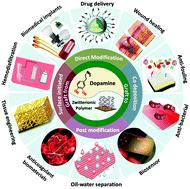当前位置:
X-MOL 学术
›
Chem. Soc. Rev.
›
论文详情
Our official English website, www.x-mol.net, welcomes your feedback! (Note: you will need to create a separate account there.)
Bioinspired dopamine and zwitterionic polymers for non-fouling surface engineering
Chemical Society Reviews ( IF 46.2 ) Pub Date : 2021-09-03 , DOI: 10.1039/d1cs00658d Anika Benozir Asha 1 , Yangjun Chen 2 , Ravin Narain 1
Chemical Society Reviews ( IF 46.2 ) Pub Date : 2021-09-03 , DOI: 10.1039/d1cs00658d Anika Benozir Asha 1 , Yangjun Chen 2 , Ravin Narain 1
Affiliation

|
Biofouling is a serious problem in the medical, marine, and all other industrial fields as it poses significant health risks and financial losses. Therefore, there is a great demand for endowing surfaces with antifouling properties to mitigate biofouling. Zwitterionic polymers (containing an equimolar number of homogeneously distributed anionic and cationic groups on the polymer chains) have been used extensively as one of the best antifouling materials for surface modification. Being a superhydrophilic polymer, zwitterionic polymers need a strong binding agent to continue to remain attached to the surface for long-term applications. The use of a mussel-inspired dopamine adhesive functional layer is one of the most widely exploited approaches for the attachment of a zwitterion layer on the surface via thiol and amine chemistry. Based on recent studies, we have categorized this dopamine and zwitterion conjugation into four different approaches: (1) conjugation of dopamine with zwitterions by direct modification of zwitterions with the dopamine functional moiety; (2) co-deposition of dopamine with zwitterionic polymers; (3) zwitterionic post modification of the polydopamine (PDA) coated surface; and (4) surface-initiated polymerization of zwitterionic polymers using dopamine modified initiators. In this review, we have briefly discussed about all the possible conjugation mechanisms and reactions for this promising dopamine and zwitterion conjugation and how this conjugated system significantly contributes to the development of non-fouling surfaces along with the other applications.
中文翻译:

用于非污染表面工程的仿生多巴胺和两性离子聚合物
生物污垢是医疗、海洋和所有其他工业领域的一个严重问题,因为它会带来重大的健康风险和经济损失。因此,非常需要赋予表面防污性能以减轻生物污损。两性离子聚合物(在聚合物链上含有等摩尔数的均匀分布的阴离子和阳离子基团)已被广泛用作表面改性的最佳防污材料之一。作为一种超亲水聚合物,两性离子聚合物需要一种强粘合剂才能长期保持附着在表面上。使用受贻贝启发的多巴胺粘合功能层是最广泛开发的方法之一,用于通过以下方式将两性离子层附着在表面上硫醇和胺化学。根据最近的研究,我们将这种多巴胺和两性离子的结合分为四种不同的方法:(1)通过直接修饰多巴胺功能部分的两性离子,使多巴胺与两性离子结合;(2) 多巴胺与两性离子聚合物的共沉积;(3)聚多巴胺(PDA)涂层表面的两性离子后改性;(4)使用多巴胺改性的引发剂表面引发的两性离子聚合物聚合。在这篇综述中,我们简要讨论了这种有前途的多巴胺和两性离子共轭的所有可能的共轭机制和反应,以及这种共轭系统如何显着促进无污染表面的发展以及其他应用。
更新日期:2021-09-03
中文翻译:

用于非污染表面工程的仿生多巴胺和两性离子聚合物
生物污垢是医疗、海洋和所有其他工业领域的一个严重问题,因为它会带来重大的健康风险和经济损失。因此,非常需要赋予表面防污性能以减轻生物污损。两性离子聚合物(在聚合物链上含有等摩尔数的均匀分布的阴离子和阳离子基团)已被广泛用作表面改性的最佳防污材料之一。作为一种超亲水聚合物,两性离子聚合物需要一种强粘合剂才能长期保持附着在表面上。使用受贻贝启发的多巴胺粘合功能层是最广泛开发的方法之一,用于通过以下方式将两性离子层附着在表面上硫醇和胺化学。根据最近的研究,我们将这种多巴胺和两性离子的结合分为四种不同的方法:(1)通过直接修饰多巴胺功能部分的两性离子,使多巴胺与两性离子结合;(2) 多巴胺与两性离子聚合物的共沉积;(3)聚多巴胺(PDA)涂层表面的两性离子后改性;(4)使用多巴胺改性的引发剂表面引发的两性离子聚合物聚合。在这篇综述中,我们简要讨论了这种有前途的多巴胺和两性离子共轭的所有可能的共轭机制和反应,以及这种共轭系统如何显着促进无污染表面的发展以及其他应用。


























 京公网安备 11010802027423号
京公网安备 11010802027423号